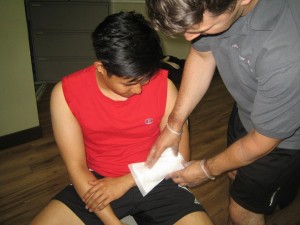Most gashes and wounds do not need medical treatment can be easily treated at home. In most cases, gashes must be closely monitored in order to prevent infection from setting in while at the same time keeping the body healthy. It is vital to be familiar to determine which gashes can be treated with basic first aid and those that require medical care. In case you are having any doubts on a particular wound, it is best to seek medical attention.
Steps on how to treat a gash wound
If a family member or colleague at work sustained a gash wound, you can take into consideration the following steps.
- Initially, you have to apply direct pressure on the wound for at least 20-30 minutes by pressing firmly using your hand and a clean towel or cloth over the wound. Do not remove the towel or cloth until 20 minutes is reached. This will help prevent any clots that have formed on the area from dislodging while at the same time keep the wound from bleeding again. In case the gash still continues to bleed after 20-30 minutes of applying direct pressure or if the flow of blood is still profuse, it is best to consult a doctor right away.
- The affected area must be elevated higher than the level of the heart if possible. This will help slow down the flow of blood to the affected area.
- A tourniquet can be used only if the wound can be considered severe. Take note that tourniquets basically close off the blood flow to a particular part of the body and can cause oxygen deprivation to the area. Tourniquets are generally reserved for gashes or wounds that were sustained during combat. Always bear this in mind before using one. In case a wound is severe enough that it would require a tourniquet, it is important to call for emergency assistance right away.
- You have to clean the gash using warm running water. Any dirt or debris from the gash must be carefully removed so that the area is thoroughly cleaned. Wash the area surrounding the gash using soap, but make sure that the soap will not enter the wound since it can cause irritation. If the gash is very deep, you have to apply pressure to the area and seek medical care.
- Apply an antibiotic ointment to the affected area and place a bandage to protect the wound.
Important tips to bear in mind

Once the bandage has been applied, make sure that it must be changed on a daily basis and if it becomes dirty or wet. You can utilize a medical tape to secure minor cuts together. On the other hand, if a particular wound has muscle or fat bulging from it, stitches are required.
Always watch out for signs of infection. If the gash swells, turns red and warm, it indicates an infection. The drainage of pus and increased pain are also signs of infection.
A gash that is longer than 1/3 of an inch requires medical attention as well as wounds that appear deep, sustained in the face or easily separates.
